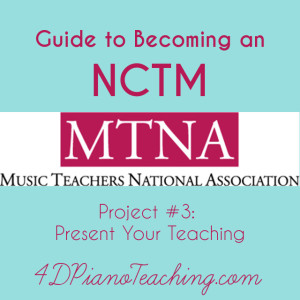 It’s time to tackle what I believe to be the most time consuming of the 5 teacher profile projects: Project #3 – Present Your Teaching. The main component of this project is the teaching video, but there’s a few other components as well. There are three main portions of this project:
It’s time to tackle what I believe to be the most time consuming of the 5 teacher profile projects: Project #3 – Present Your Teaching. The main component of this project is the teaching video, but there’s a few other components as well. There are three main portions of this project:
1. Three lessons video recorded of the same students. This must include a 30 minute lesson in which you introduce a new piece, a15 minute segment where you continue working on the piece introduced in the first lesson, and another 15 segment in which the presented piece is being finished and polished. Having good videos for this project requires a lot of practice videos. MTNA suggests recording for at least 4 weeks before you actually record for the project. This ensures that you are able to get a good angle for viewing and hearing the lesson. You and the student must both be visible, but the printed score does not have to be visible. There are a few helpful articles on the MTNA certification website about getting quality videos. MTNA will accept video from iPads, but a better quality video is preferred. I purchased a Nikon Coolpix S9300 from a Woot daily deal. This camera has 1080p HD video and is small and compact. It also served as a good replacement of my previous Nikon Coolpix camera that I had been using since high school graduation (yikes!). The only drawback that I’ve found is it will only record 29 minutes on one video, not quite a full 30 minutes (no matter how large your memory card). I’ve countered this by just stopping and restarting the video once during the lesson time. You may keep several students in mind as possibilities for the video project. Get used to video taping all their lessons, and then see which videos you are happiest with for the final project.
2. Supporting written materials. This section asks for a written synopsis of each of the video segments above along with a self-evaluation of the lesson and your future goals for the students. You also have to submit materials that show how you assess the outcomes of your teaching. You can choose from things such as festival critique sheets, theory exams, video of student recital performances, written progress reports, or an outline of how you conduct student/parent evaluation conferences. Some of these items you may have to plan ahead on and start collecting examples from your students, so start gathering now.
3. Teacher Performance. The final requirement is a short video of you performing something. This verifies to the committee that you actually can play piano, probably a necessary skill for being a piano teacher :).
So there you have it – that’s the biggest project for your certification. Once you finish this, the rest should be a breeze!
Other posts in this series:
Author: Spring
Spring Seals, NCTM, teaches 60 piano students ranging from age 3 to 70 in Fort Worth, Texas. She also serves as the Director of Certification for TMTA. She is passionate about helping teachers become more effective in their studios through professional development, new resources, and fresh ideas.
